INSTITUT SUPERIEUR D'ANTHROPOLOGIE
INSTITUTE OF ANTHROPOLOGY
ONLINE COURSES / COURS A DISTANCE
SPRING SESSION : APRIL 2013
REGISTER NOW
FRANCE –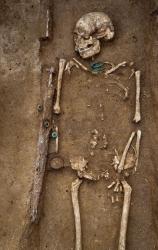
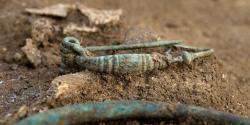 Buchères - Des épées dans leur fourreau et des lances, des boucliers dont ne subsistent que le cerclage métallique et l'arête centrale, des fibules de fer ou de bronze, parfois rehaussées de corail... Tels sont les objets exhumés de cinq tombes de guerriers gaulois faisant partie d'une nécropole des IVe et IIIe siècles avant notre ère sur le site du Parc logistique de l'Aube, à Buchères. Cet ensemble funéraire comprend des enclos monumentaux plus anciens encore. Mis au jour par une équipe de l'Institut national de recherches archéologiques préventives, il est en cours de fouille.
Buchères - Des épées dans leur fourreau et des lances, des boucliers dont ne subsistent que le cerclage métallique et l'arête centrale, des fibules de fer ou de bronze, parfois rehaussées de corail... Tels sont les objets exhumés de cinq tombes de guerriers gaulois faisant partie d'une nécropole des IVe et IIIe siècles avant notre ère sur le site du Parc logistique de l'Aube, à Buchères. Cet ensemble funéraire comprend des enclos monumentaux plus anciens encore. Mis au jour par une équipe de l'Institut national de recherches archéologiques préventives, il est en cours de fouille.
http://www.lemonde.fr/sciences/article/2013/04/11/des-guerriers-gaulois-pres-de-troyes_3158431_1650684.html
INDONESIE –  - Harimau Cave - Prof Simanjuntak is part of a group excavating Harimau ("Tiger") Cave in Sumatra, which has yielded "some very, very impressive finds". Among these is the first example of rock art in Sumatra and the discovery of 66 human burials dating back about 3000 years. "Sixty-six is very strange," Prof Simanjuntak said. "We've never found it before, such a big quantity of burials. "It means that this cave was occupied intensely by humans and they continued to occupy it for a very, very long time. "There is still occupation traces deeper and deeper in the cave, where we have not excavated yet. So it means the cave is very promising." There are also plant and animal remains like chickens, dogs and pigs, suggesting these people had been domesticated rather than nomadic. Prof Simanjuntak said Harimau Cave was one of many in the area. "At the Harimau Cave's surrounding areas there are so many, many caves," he said. "Up to now we have encountered up to 50 caves in the area and most of the caves contain archaeological evidence. "It means that at that time, this area had been intensively occupied by humans. They lived in community in each cave, maybe around 10 or 20 families, and they had contact with each other."
- Harimau Cave - Prof Simanjuntak is part of a group excavating Harimau ("Tiger") Cave in Sumatra, which has yielded "some very, very impressive finds". Among these is the first example of rock art in Sumatra and the discovery of 66 human burials dating back about 3000 years. "Sixty-six is very strange," Prof Simanjuntak said. "We've never found it before, such a big quantity of burials. "It means that this cave was occupied intensely by humans and they continued to occupy it for a very, very long time. "There is still occupation traces deeper and deeper in the cave, where we have not excavated yet. So it means the cave is very promising." There are also plant and animal remains like chickens, dogs and pigs, suggesting these people had been domesticated rather than nomadic. Prof Simanjuntak said Harimau Cave was one of many in the area. "At the Harimau Cave's surrounding areas there are so many, many caves," he said. "Up to now we have encountered up to 50 caves in the area and most of the caves contain archaeological evidence. "It means that at that time, this area had been intensively occupied by humans. They lived in community in each cave, maybe around 10 or 20 families, and they had contact with each other."
http://www.illawarramercury.com.au/story/1423599/art-bodies-found-in-ancient-caves/?cs=300
FRANCE –  Harly - C'est une découverte extraordinaire qui occupe les archéologues de l'Inrap, l'Institut national de recherches archéologiques préventives, depuis octobre 2012 : 180 tombes et quelque 250 squelettes et restes humains de l'époque mérovingienne ont été prélevés à Harly, près de Saint-Quentin (Aisne). Les chercheurs ont ainsi mis à jour le cimetière d'un village médiéval, datant entre 700 et 800 ans après Jésus-Christ. Le site de la fouille, probablement repéré dans un premier temps au XIXe siècle sans études approfondies, est traversé par une tranchée de la guerre 1914-1918. Une cinquantaine de sépultures avaient, semble-t-il, été réarrangées pour permettre de loger un deuxième corps. D'où le nombre de squelettes beaucoup plus grand que celui des tombes. La nécropole s'étend sur environ 800 à 1 000 mètres carrés. Selon les premières constatations d'Estelle Pinard, archéo-anthropologue responsable de l'opération, le village aurait mené une vie paisible à l'époque mérovingienne, période qui n'a pas été interrompue par des épidémies ou des guerres. Par ailleurs, l'orientation est-ouest des tombes correspond aux normes de la religion chrétienne. Aucun objet n'a été retrouvé aux côtés des squelettes. Mais un seul caveau a été mis à jour et la situation des corps pousse à croire qu'ils ont été enterrés dans des cercueils en bois. «On les fouille, on les enregistre, on les prélève. Puis les squelettes vont être nettoyés, étudiés, on va faire de l'anthropologie biologique», s'est réjoui l'archéo-anthropologue. A terme, les recherches devraient permettre de déterminer s'ils portaient des vêtements et s'ils étaient dans des linceuls.
Harly - C'est une découverte extraordinaire qui occupe les archéologues de l'Inrap, l'Institut national de recherches archéologiques préventives, depuis octobre 2012 : 180 tombes et quelque 250 squelettes et restes humains de l'époque mérovingienne ont été prélevés à Harly, près de Saint-Quentin (Aisne). Les chercheurs ont ainsi mis à jour le cimetière d'un village médiéval, datant entre 700 et 800 ans après Jésus-Christ. Le site de la fouille, probablement repéré dans un premier temps au XIXe siècle sans études approfondies, est traversé par une tranchée de la guerre 1914-1918. Une cinquantaine de sépultures avaient, semble-t-il, été réarrangées pour permettre de loger un deuxième corps. D'où le nombre de squelettes beaucoup plus grand que celui des tombes. La nécropole s'étend sur environ 800 à 1 000 mètres carrés. Selon les premières constatations d'Estelle Pinard, archéo-anthropologue responsable de l'opération, le village aurait mené une vie paisible à l'époque mérovingienne, période qui n'a pas été interrompue par des épidémies ou des guerres. Par ailleurs, l'orientation est-ouest des tombes correspond aux normes de la religion chrétienne. Aucun objet n'a été retrouvé aux côtés des squelettes. Mais un seul caveau a été mis à jour et la situation des corps pousse à croire qu'ils ont été enterrés dans des cercueils en bois. «On les fouille, on les enregistre, on les prélève. Puis les squelettes vont être nettoyés, étudiés, on va faire de l'anthropologie biologique», s'est réjoui l'archéo-anthropologue. A terme, les recherches devraient permettre de déterminer s'ils portaient des vêtements et s'ils étaient dans des linceuls.
http://www.leparisien.fr/societe/250-squelettes-merovingiens-decouverts-dans-l-aisne-11-04-2013-2717793.php
POLOGNE – 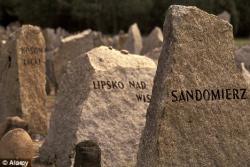 Treblinka - A British forensic archaeologist has unearthed fresh evidence to prove the existence of mass graves at the Nazi death camp Treblinka - scuppering the claims of Holocaust deniers who say it was merely a transit camp. Some 800,000 Jews were killed at the site, in north east Poland, during the Second World War but a lack of physical evidence in the area has been exploited by Holocaust deniers. Sturdy Colls said: 'All the history books state that Treblinka was destroyed by the Nazis but the survey has demonstrated that simply isn’t the case. 'I’ve identified a number of buried pits using geophysical techniques. These are considerable in size, and very deep, one in particular is 26 by 17 metres.' The programme’s presenter says that the pits contain the burnt remains of thousands of bodies.
Treblinka - A British forensic archaeologist has unearthed fresh evidence to prove the existence of mass graves at the Nazi death camp Treblinka - scuppering the claims of Holocaust deniers who say it was merely a transit camp. Some 800,000 Jews were killed at the site, in north east Poland, during the Second World War but a lack of physical evidence in the area has been exploited by Holocaust deniers. Sturdy Colls said: 'All the history books state that Treblinka was destroyed by the Nazis but the survey has demonstrated that simply isn’t the case. 'I’ve identified a number of buried pits using geophysical techniques. These are considerable in size, and very deep, one in particular is 26 by 17 metres.' The programme’s presenter says that the pits contain the burnt remains of thousands of bodies.
http://www.dailymail.co.uk/news/article-2087735/British-archaeologist-discovers-fresh-evidence-mass-graves-World-War-Two-death-camp-Treblinka.html?ITO=1490&ns_mchannel=rss&ns_campaign=1490
ROYAUME UNI – 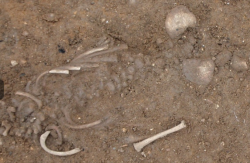 Huntingdon - A baby’s skeleton from the medieval period is among artefacts found by archaeologists excavating the site of the Huntingdon link road. Experts identified the child as a stillborn of about the 28 to 36-week stage of pregnancy and the tiny remains could have been there since the 13th century. The infant skeleton was one of several pieces of new evidence of medieval settlement at a site near Ermine Street – other finds include a blacksmith’s hearth, a cobbled street and pottery dating back to the 11th Century. Archaeologists at the site believe they may have only scratched the surface of the area they are excavating, which is thought to be in the vicinity of the lost church of St Andrew’s and a former Roman road. Senior project manager for the Oxford Archaeology East team Aileen Connor said the baby was most likely stillborn. “One possibility is that the baby was born dead and that they have buried it in the house,” she said. Another possibility, although less likely according to Mrs Connor, is the baby could have been given a church burial at St Andrew’s. “It is possible that if we’re on the edge of a church yard we will find more human remains,” Mrs Connor said. “However, it’s all looking like houses at the moment.” The evidence of housing is a new development because the site is outside the known extent of the medieval settlement of Huntingdon. Experts have said there appears to be a cobbled street, indicating a number of dwellings. Mrs Connor said: “It’s all about building up a story of how the site relates to Huntingdon.” Also uncovered are a blacksmith’s hearth, which may have been a small trade serving a few families, and pottery which dates back to the period shortly after the Norman Conquest. The excavations are expected to continue until early June.
Huntingdon - A baby’s skeleton from the medieval period is among artefacts found by archaeologists excavating the site of the Huntingdon link road. Experts identified the child as a stillborn of about the 28 to 36-week stage of pregnancy and the tiny remains could have been there since the 13th century. The infant skeleton was one of several pieces of new evidence of medieval settlement at a site near Ermine Street – other finds include a blacksmith’s hearth, a cobbled street and pottery dating back to the 11th Century. Archaeologists at the site believe they may have only scratched the surface of the area they are excavating, which is thought to be in the vicinity of the lost church of St Andrew’s and a former Roman road. Senior project manager for the Oxford Archaeology East team Aileen Connor said the baby was most likely stillborn. “One possibility is that the baby was born dead and that they have buried it in the house,” she said. Another possibility, although less likely according to Mrs Connor, is the baby could have been given a church burial at St Andrew’s. “It is possible that if we’re on the edge of a church yard we will find more human remains,” Mrs Connor said. “However, it’s all looking like houses at the moment.” The evidence of housing is a new development because the site is outside the known extent of the medieval settlement of Huntingdon. Experts have said there appears to be a cobbled street, indicating a number of dwellings. Mrs Connor said: “It’s all about building up a story of how the site relates to Huntingdon.” Also uncovered are a blacksmith’s hearth, which may have been a small trade serving a few families, and pottery which dates back to the period shortly after the Norman Conquest. The excavations are expected to continue until early June.
http://www.huntspost.co.uk/news/latest-news/13th_century_stillborn_found_at_huntingdon_dig_1_2012531
ROYAUME UNI – Chester Green - Yesterday, archaeologists began an intensive dig to discover Roman remains in Chester Green. Chris Jones reports. Perched on a carefully peeled-back roll of turf were several muddy bits of orange pottery which are some of the oldest objects in Derby – dating back 1,500 years at least. It is on this site that a team of archaeologists will sink a series of trenches over the next couple of weeks in an attempt to decisively chart the extent of Roman ruins under the surface. It has long been known that there are buildings – a fort and what is believed to be a bath house – buried in Chester Green. Much of this was discovered by the last professional dig in the area, back in the 1920s. But the Environment Agency has drawn up plans to improve defences along the River Derwent to protect Derby from rare, catastrophic flooding. As these plans involve bolstering existing walls and embankments in Chester Green and along City Road, as part of the planning process, an examination of the Roman ruins in the ground was scheduled to be carried out. Therefore, two digs are planned over the coming months. The first, which started yesterday, will cover Parker's Piece. The second will take place in the Darley Playing Fields next month.
http://www.thisisderbyshire.co.uk/Archaeologists-hoping-cricket-pitch-dig-runs-fine/story-18663124-detail/story.html#axzz2Q4yowNiV
ISRAËL – 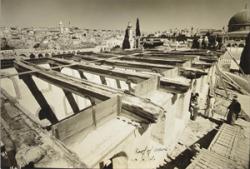 Jérusalem - The Romans destroyed Herod’s Jerusalem Temple in 70 C.E. Is it possible that some of the wooden beams from his Temple Mount have survived—and may be identified? I believe the answer is “yes.” Some of the beams may even be from the Temple. Wooden beams of this quality—especially Cedar of Lebanon (Cedrus libani) and cypress (Cypressus sempervirens)—were extremely valuable and would have been used and reused, again and again. Known to archaeologists as “secondary use,” the phenomenon of reuse is widely recognized, mostly in connection with stone building blocks but also with regard to other construction elements such as columns, capitals and bases. The same is true for wood. It was used again whenever possible.
Jérusalem - The Romans destroyed Herod’s Jerusalem Temple in 70 C.E. Is it possible that some of the wooden beams from his Temple Mount have survived—and may be identified? I believe the answer is “yes.” Some of the beams may even be from the Temple. Wooden beams of this quality—especially Cedar of Lebanon (Cedrus libani) and cypress (Cypressus sempervirens)—were extremely valuable and would have been used and reused, again and again. Known to archaeologists as “secondary use,” the phenomenon of reuse is widely recognized, mostly in connection with stone building blocks but also with regard to other construction elements such as columns, capitals and bases. The same is true for wood. It was used again whenever possible.
http://members.bib-arch.org/publication.asp?PubID=BSBA&Volume=39&Issue=3&ArticleID=3&mqsc=E%%$__campaign_id%%&utm_source=WhatCountsEmail&utm_medium=BHD+Daily%20Newsletter&utm_campaign=E3B410